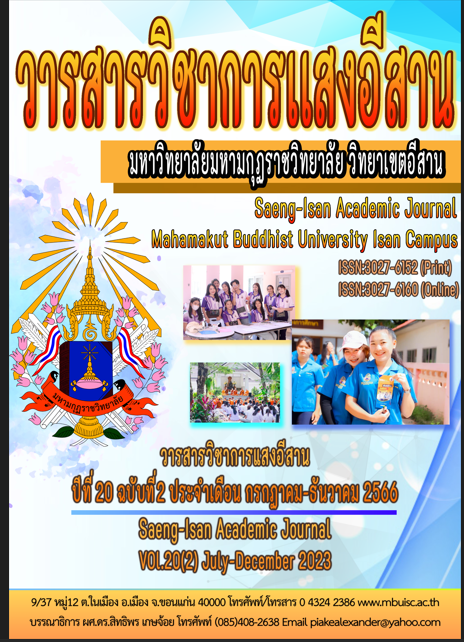รูปแบบการเสริมสร้างชุมชนเข้มแข็งวิถีพุทธของวิสาหกิจชุมชนกลุ่มทอผ้า ตำบลแม่วะ อำเภอเถิน จังหวัดลำปาง
คำสำคัญ:
รูปแบบ, ชุมชนเข้มแข็ง, วิสาหกิจชุมชนบทคัดย่อ
The purposes of this research were 1) to study the context of weaving group community enterprise in Mae Wa Subdistrict, Thoen District, Lampang Province; 2) to study the process of Buddhist building strength in communities of weaving community enterprises in Mae Wa Sub-district, Thoen District, Lampang Province; and 3) to propose a model for Buddhist strengthening communities of weaving community enterprises in Mae Wa Sub-district, Thoen District, Lampang Province. This study was a qualitative research method using documents tool and in-depth interviews with 17 key informants. Data were analyzed by descriptive content.
The finding were as follows; 1) Community enterprise of weaving group is established a community enterprise by using the local knowledge that has been passed down from ancestors in weaving community. The group has applied and adapted the products as their identity and was selected to get award for producing 4-star woven fabrics with unique techniques based on nature with local wisdom. It makes the weaving group able to rely on themselves and get income from woven fabric products with their own unique.
2) The process of Buddhist strengthening community are divided into 6 factors namely; 1) Finding an alliance with ideas; 2) Establish group under the Act on Promotion of Community Enterprises; 3) Management group is suitable for each other; 4) Participation of communities; 5) Support of government; and 6) network of weaving groups.
3) Models of Buddhist strengthening communities of weaving group community enterprises include: 1) the models with self-reliant as follows: (1.1) Production and tools appropriate to their own knowledge; (1.2) Knowledge transfer to the next; (1.3) Promoting weaving as a main occupation; and (1.4) Cooperation. 2) The self-reliance model according to the TERMS theory as follows: (2.1) the Communities use innovations to increase product quantity and quality; (2.2) community enterprises can generate income and become self-reliant; (2.3) the community enterprises produce products as the sympathize with environment; (2.4) the Community Enterprise has a generous heart and sympathize with each other; and (2.5) the Community Enterprise has encouraged physically, mentally, socially and emotionally. 3) The Buddhist Model of strengthen promotion, namely: (3.1) the members of group know how to sacrifice things, knowledge and good behavior; (2.2) the members had spoken polite words and encourage each other; (3.3) the members know how to practice oneself for the benefit of themselves and others; and (3.4) the members are consistently posing to help and support each other.
References
เกศินี บัวดิศ. (2560). ผ้าทอพื้นเมืองของชาวอีสาน. วารสารพื้นถิ่นโขง ชี มูล, ปีที่ 3 ฉบับที่ 1 ประจำเดือนมกราคม – มิถุนายน 2560, หน้า 55-84.
ชฎากาญจน์ เจริญรบ และคณะ. (2555). การพัฒนาวิสาหกิจชุมชนตามแนวเศรษฐกิจพอเพียง. เอกสารข่าวสารงานวิจัยและพัฒนา, ปีที่ 11 ฉบับที่ 124 ประจำเดือนธันวาคม 2555, หน้า 1 - 5.
ณมน ธนินธญางกูร วรพจน์ พรหมจักร และสุภิภัตร์ บุญแน่น. (2561). การอนุรักษ์ภูมิปัญญาการทอผ้าฝ้ายบ้านหนองกุงจารย์ผาง กรณีศึกษา: กลุ่มถักทอไท บ้านหนองกุงจารย์ผาง ตำบลหนองเรือ อำเภอโนนสัง จังหวัดหนองบัวลำภู. วารสารมหาวิทยาลัยราชภัฏร้อยเอ็ด, ปีที่ 12 ฉบับที่ 2 ประจำเดือนกรกฎาคม – ธันวาคม 2561, หน้า 23-34.
ณัฐริกา บุตรศรี และคณะ. (2563). การถ่ายทอดภูมิปัญญาพื้นบ้านในการทอผ้าไหม บ้านหลุ่งประดู่ ตำบลหลุ่งประดู่ อำเภอห้วยแถลง จังหวัดนครราชสีมา. HUSO Journal of Humanities and Social Sciences, ปีที่ 4 ฉบับที่ 1 ประจำเดือนมกราคม – เมษายน 2563, หน้า 56 - 67.
ไทยโรจน์ พวงมณี และคณะ. (2565). แนวทางการพัฒนาศักยภาพกลุ่มวิสาหกิจชุมชนกลุ่มทอผ้าบ้านก้างปลา ตำบลชัยพฤกษ์ อำเภอเมือง จังหวัดเลย. วารสารวิจัยและพัฒนา มหาวิทยาลัยราชภัฏเลย, ปีที่ 17 ฉบับที่ 61 ประจำเดือนกรกฎาคม – กันยายน 2565, หน้า 89 - 98.
นางข่าย แก้วแสนสาย. (2566, 14 มิถุนายน). สัมภาษณ์โดย พระประจักษณ์นพกิจ [การบันทึกเสียง]. ประธานกลุ่มทอผ้าบ้านแม่วะท่าช้าง ตำบลแม่วะ อำเภอเถิน จังหวัดลำปาง.
นางแดง อริยะดิบ. (2566, 14 มิถุนายน). สัมภาษณ์โดย พระประจักษณ์นพกิจ [การบันทึกเสียง]. สมาชิกชุมชนบ้านแม่วะท่าช้าง ตำบลแม่วะ อำเภอเถิน จังหวัดลำปาง.
ปารมี แก้วสีพันดอน และคณะ. (2561). บทบาทสตรีในการสืบทอดอาชีพการทอผ้าไหม บ้านสะผ่าย เมืองชะนะสมบูน แขวงจำปาสัก สาธารณรัฐประชาธิปไตยประชาชนลาว. วารสารวิชาการการจัดการเทคโนโลยีสารสนเทศและนวัตกรรม, ปีที่ 5 ฉบับพิเศษ 2561, หน้า 9-14.
ปิลันลน์ ปุณญประภา และคณะ. (2561). ปัจจัยที่ทำให้เกิดปัญหาต่อภูมิปัญญาและการสืบทอดผ้าทอไทยพวน บ้านใหม่ จังหวัดนครนายก. วารสารวิชาการนวัตกรรมสื่อสารสังคม (The Journal of Social Communication Innovation), ปีที่ 6 ฉบับที่ 1 ประจำเดือนมกราคม – มิถุนายน, หน้า 159-168.
พระปลัดณรงค์ศักดิ์ วิสุทฺธิเมธี และสุขี มากมูลดี. (2562). สังคหวัตถุองค์ธรรมแห่งการสังคมสงเคราะห์. วารสารพุทธมัคค์ ศูนย์วิจัยธรรมศึกษา สำนักเรียนวัดอาวุธวิกสิตาราม, ปีที่ 4 ฉบับที่ 2 ประจำเดือนกรกฎาคม-ธันวาคม 2562, หน้า 10 – 19.
พระมหาสุทิตย์ อาภากโร (อบอุ่น). (2548). นวัตกรรมการเรียนรู้ : คน ชุมชน และการพัฒนา. กรุงเทพมหานคร : โครงการเสริมสร้างการเรียนรู้เพื่อชุมชนเป็นสุข (สรส.).
ภัทรานิษฐ์ สิทธินพพันธ์.(2565). การพัฒนารูปแบบและสร้างมูลค่าเพิ่มให้กับสิ่งทอชุมชนพื้นที่จังหวัดสุพรรณบุรี (วิสาหกิจชุมชนกลุ่มทอผ้าพื้นเมืองลายโบราณบ้านสระบัวก่ำ). Journal of Community Development Research (Humanities and Social Sciences,ปีที่ 14 ฉบับที่ 4 ประจำเดือนตุลาคม - ธันวาคม 2565,หน้า 128 - 241.
สำนักงานเลขานุการคณะกรรมการส่งเสริมวิสาหกิจชุมชน. (2548). พระราชบัญญัติส่งเสริมวิสาหกิจชุมชน พ.ศ. 2548. กรุงเทพมหานคร : สำนักงานเลขานุการคณะกรรมการส่งเสริมวิสาหกิจชุมชน.
สุวัฒน์ คงแป้น. ชุมชนท้องถิ่นกำหนดอนาคตประเทศไทย. กรุงเทพมหานคร : สำนักสื่อสารการพัฒนา สถาบันองค์กรชุมชน (องค์การมหาชน), 2541,หน้า 7.
เสรี พงศ์พิศ. (2548). แนวคิดชุมชนเข้มแข็ง. กรุงเทพมหานคร : เจริญวิทย์การพิมพ์,หน้า 51.
อรณิชชา ทศตา สุกัญญา ใจอดทน และศิริกาญจนษ พิลาบุตร.(2563). การถ่ายทอดภูมิปัญญาพื้นบ้านในการทอผ้าไหม อำเภอปักธงชัย จังหวัดนครราชสีมา. วารสารวิชาการนอร์ทเทิร์น, ปีที่ 7 ฉบับที่ 1 ประจำเดือนมกราคม – มีนาคม 2563, หน้า 88 – 99.
Downloads
เผยแพร่แล้ว
ฉบับ
บท
License
Copyright (c) 2023 วารสารวิชาการแสงอีสาน Saeng-Isan Academic Journal ISSN:3027-6152(Print), ISSN:3027-6160(Online)

This work is licensed under a Creative Commons Attribution-NonCommercial-NoDerivatives 4.0 International License.
เนื้อหาและข้อมูลในบทความที่ตีพิมพ์ในวารสาร ถือเป็นข้อคิดเห็นและความรับผิดชอบของผู้เชียนบทความโดยตรง ซึ่งวารสารไม่มีส่วนเกี่ยวข้อง นอกจากนั้น ผู้เขียนทุกท่านต้องยืนยันว่าบทความต้นฉบับที่ส่งมาตีพิมพ์เผยแพร่นั้น จะต้องไม่เป็นบทความที่กำลังอยู่ในการพิจารณาเพื่อตีพิมพ์ในวารสารอื่นหรือเคยตีพิมพ์เผยแพร่มาแล้ว หากมีการใช้ภาพ ข้อความหรือตารางของผู้เขียนหรือผู้นิพนธ์ท่านอื่น ผู้เขียนจะต้องอ้างแหล่งที่มาหรือเจ้าของลิขสิทธ์
Publication Ethic:
The detail published in Saeng Isan Journal is opinion and responsibility of the authors, and it is not relevant with the jouranl. Besides, the authors must certify that the original manuscript is not in the process to publish in other journals or used to publish in other journals. If the authors use paragraphs, pictures or tables from others, the athours must refer to the original sources.
Article Consideration:
Each article will be published by a panel three journalists with expertise in relevant fields, and get the editorial approval before publishing. The review is in the form of The article's double blind.
To comply with copyright law. The author must sign the copy of the article submission form to the journal. In addition, the author must confirm that the original article submitted to the journal is only one publication in Saeng Isan Journal. If the images or tables of other authors appearing in other publications are used, the author must ask permission of the copyright owner before publishing.

